-
 The Royal Society of Arts on the Circular Economy Through the Centuries
The Royal Society of Arts on the Circular Economy Through the Centuries -
 Graphite Separation from Lithium-Ion Battery Black Mass Using Froth Flotation and Quality Evaluation for Reuse as a Secondary Raw Material Including Non-Battery Applications
Graphite Separation from Lithium-Ion Battery Black Mass Using Froth Flotation and Quality Evaluation for Reuse as a Secondary Raw Material Including Non-Battery Applications -
 Logistic Regression Insights on Pyrolysis vs. Recycling
Logistic Regression Insights on Pyrolysis vs. Recycling
Journal Description
Recycling
Recycling
is an international, peer-reviewed, open access journal on the recycling and reuse of material resources, including circular economy published bimonthly online by MDPI.
- Open Access— free for readers, with article processing charges (APC) paid by authors or their institutions.
- High Visibility: indexed within Scopus, ESCI (Web of Science), FSTA, Inspec, AGRIS, and other databases.
- Journal Rank: CiteScore - Q1 (Management, Monitoring, Policy and Law)
- Rapid Publication: manuscripts are peer-reviewed and a first decision is provided to authors approximately 20.9 days after submission; acceptance to publication is undertaken in 4.9 days (median values for papers published in this journal in the first half of 2025).
- Recognition of Reviewers: reviewers who provide timely, thorough peer-review reports receive vouchers entitling them to a discount on the APC of their next publication in any MDPI journal, in appreciation of the work done.
Impact Factor:
4.6 (2024);
5-Year Impact Factor:
4.9 (2024)
Latest Articles
An Experimental Investigation into the Performance of Concrete and Mortar with Partial Replacement of Fine Aggregate by Printed Circuit Board (PCB) E-Waste
Recycling 2025, 10(4), 138; https://doi.org/10.3390/recycling10040138 (registering DOI) - 12 Jul 2025
Abstract
The increasing accumulation of E-waste presents significant environmental challenges, particularly its disposal and resource management. The present study investigates the potential of printed circuit boards (PCBs) as a partial replacement for fine aggregates in cement mortar and concrete. The replacement levels of PCBs
[...] Read more.
The increasing accumulation of E-waste presents significant environmental challenges, particularly its disposal and resource management. The present study investigates the potential of printed circuit boards (PCBs) as a partial replacement for fine aggregates in cement mortar and concrete. The replacement levels of PCBs ranged from 0 to 35 wt% in cement mortar and from 0 to 30 wt% in concrete, aiming to improve the qualities of both mixes. The specimens were cured for 7 and 28 days, respectively, followed by tests to evaluate the flowability and static mechanical properties. The performance of the developed mortar/concrete was analyzed under aggressive environmental conditions by conducting various durability tests. Properties such as acoustic and thermal conductivity were also evaluated to check the suitability of the developed material for its multifunctionality. Test results revealed that the optimal replacement percentages of fine aggregate by PCBs in mortar and concrete mixes were 25 wt% and 20 wt%, respectively. A decline in mechanical properties was observed after a further increase in replacement level. The results demonstrate the feasibility of E-waste integration in cement and mortar as a sustainable waste management solution.
Full article
Open AccessArticle
Selective Ammonium Recovery from Livestock and Organic Solid Waste Digestates Using Zeolite Tuff: Efficiency and Farm-Scale Prospects
by
Matteo Alberghini, Giacomo Ferretti, Giulio Galamini, Cristina Botezatu and Barbara Faccini
Recycling 2025, 10(4), 137; https://doi.org/10.3390/recycling10040137 - 8 Jul 2025
Abstract
►▼
Show Figures
Implementing efficient strategies for the circular recovery and reuse of nutrients from wastewaters is mandatory to meet the Green Deal objectives and Sustainable Development Goals. In this context we investigated the use of zeolitic tuff (containing chabazite and phillipsite) in the selective recovery
[...] Read more.
Implementing efficient strategies for the circular recovery and reuse of nutrients from wastewaters is mandatory to meet the Green Deal objectives and Sustainable Development Goals. In this context we investigated the use of zeolitic tuff (containing chabazite and phillipsite) in the selective recovery and reuse of N from various anaerobic liquid digestates in view of their implementation in farm-scale treatment plants. We tested the method on three livestock digestates and two municipal organic solid waste digestates. Adsorption isotherms and kinetics were assessed on each digestate, and a large set of parameters, including (i) contact time, (ii) initial NH4+ concentration, (iii) presence of competing ions, (iv) total solids content, and (vi) separation methods (microfiltration and clarification), were considered in the experimental design. Our results showed that the adsorption mechanism can be explained by the Freundlich model (R2 up to 0.97), indicating a multilayer and heterogeneous adsorption, while the kinetic of adsorption can be explained by the pseudo-second-order model, indicating chemical adsorption and ion exchange. The efficiency in the removal of NH4+ was indirectly related to the K+ and total solids content of the digestate. Maximum NH4+ removal exceeded 90% in MSW-derived digestates and 80% within 60 min in livestock-derived digestates at a 5% solid/liquid ratio. Thermodynamic parameters confirmed favorable and spontaneous adsorption (ΔG up to −7 kJ⋅mol−1). Farm-scale projections estimate a nitrogen recovery potential of 1.2 to 16 kg N⋅day−1, depending on digestate type and process conditions. These findings support the application of natural zeolitic tuffs as a low-cost, chemical-free solution for ammonium recovery, contributing to sustainable agriculture and circular economy objectives.
Full article

Figure 1
Open AccessArticle
Thermodynamic Assessment of the Pyrometallurgical Recovery of a Pb-Ag Alloy from a Mixture of Ammonium Jarosite–Lead Paste Wastes
by
Jose Enrique Sanchez Vite, Alejandro Cruz Ramírez, Manuel Eduardo Flores Favela, Ricardo Gerardo Sánchez Alvarado, José Antonio Romero Serrano, Margarita García Hernández, Teresita del Refugio Jiménez Romero and Juan Cancio Jiménez Lugos
Recycling 2025, 10(4), 136; https://doi.org/10.3390/recycling10040136 - 8 Jul 2025
Abstract
A previously pyrometallurgical process, developed to obtain a Pb-Ag alloy and a slag rich in sulfur from the recycling of a mixture of industrial wastes of jarosite and lead paste, was thermodynamically assessed at 1200 °C. The industrial jarosite sourced from a Mexican
[...] Read more.
A previously pyrometallurgical process, developed to obtain a Pb-Ag alloy and a slag rich in sulfur from the recycling of a mixture of industrial wastes of jarosite and lead paste, was thermodynamically assessed at 1200 °C. The industrial jarosite sourced from a Mexican zinc hydrometallurgical plant corresponded to an ammonium jarosite with a measurable silver content. The specific heat capacity (Cp) of the ammonium jarosite was obtained from TGA and DSC measurements, as well as the thermodynamic functions of enthalpy, entropy, and Gibbs free energy. The Cp was successfully modeled using polynomial regression, with a second-degree polynomial employed to describe the low-temperature behavior. The thermodynamic data generated were input into the thermodynamic software FactSage 8.2 for modeling of the lead paste–ammonium jarosite-Na2CO3-SiC system and represented by stability phase diagrams. The thermodynamic assessment of the pyrometallurgical process predicted compounds formed at high temperatures, showing that a Pb-Ag alloy and a slag rich in Na, S, and Fe (NaFeS2 and NaFeO2) were obtained. The compounds formed evidence of the effective sulfur retention in the slag, which is crucial for mitigating SO2 emissions during high-temperature treatments. The experimental compounds, after solidification, were determined by X-ray diffraction measurements to be Na2Fe(SO4)2 and Na2(SO4), which reasonably match the thermodynamic assessment. The heat capacity of the ammonium jarosite provides essential thermodynamic insights into the compositional complexities of industrial waste, which are particularly relevant for thermodynamic modeling and process optimization in pyrometallurgical systems aimed at metal recovery and residue valorization.
Full article
(This article belongs to the Topic Sustainable Recycling and Reuse of Industrial By-Products or Waste from Geo-Resource Exploitation)
►▼
Show Figures

Figure 1
Open AccessArticle
Mass Distribution of Organic Carbon, S-Containing Compounds and Heavy Metals During Flotation of Municipal Solid Waste Incineration Fly Ash
by
Weifang Chen, Peng Li, Shuyue Zhang and Yifan Chen
Recycling 2025, 10(4), 135; https://doi.org/10.3390/recycling10040135 - 8 Jul 2025
Abstract
►▼
Show Figures
Flotation was investigated to treat incineration fly ash with diesel, kerosene, TX-100, or SDS as a collector and methyl isobutyl carbinol (MIBC) or 2-Octyl alcohol as a frother. Fly ash was separated into light and residual materials. Comparison of yield, carbon and sulfur
[...] Read more.
Flotation was investigated to treat incineration fly ash with diesel, kerosene, TX-100, or SDS as a collector and methyl isobutyl carbinol (MIBC) or 2-Octyl alcohol as a frother. Fly ash was separated into light and residual materials. Comparison of yield, carbon and sulfur removal showed that kerosene and MIBC showed the best performance. The results revealed that flotation was a method that could simultaneously achieve the removal of organics and S-containing compounds. Specifically, approximately 7.63–9.45% of the total mass was collected as light material, which was enriched with organic carbon. Contents of organic carbon reached 14.35 wt%–14.56 wt% in the light materials from those of 2.74 wt%–3.52 wt% in the original fly ash. Elemental analysis further proved that sulfur was also accumulated in light material. Approximately 78.84–81.69% of the organic carbon and 80.47–82.66% of the sulfur were removed. Decarbonization was primarily achieved through the flotation of organic materials, while desulfurization resulted from both flotation and the dissolution of soluble salts. Furthermore, the contents of the chloride and heavy metals in the residual fly ash also decreased. Particle size analysis showed that flotation was effective in the removal of smaller particles, and those particles were also rich in heavy metals. Overall, by selecting the right collector and frother, flotation was also able to reduce the leaching toxicity of heavy metals. The residual fly ash was safe for further disposal. Organic carbon, sulfur and heavy metals were accumulated in the light materials, which accounted for less than 10% of the original mass. The portion of fly ash needing further treatment was therefore greatly reduced.
Full article

Figure 1
Open AccessArticle
Evaluation of Plastic Waste Degradation Using Terahertz Spectroscopy for Material Recycling
by
Hitomi Sonohata, Gaku Manago, Shun Seike, Hidetoshi Kitawaki and Tadao Tanabe
Recycling 2025, 10(4), 134; https://doi.org/10.3390/recycling10040134 - 5 Jul 2025
Abstract
In Japan, the majority of waste plastics are classified into three categories: approximately 22% are used for material recycling, 3% are used for chemical recycling, and 62% are used for thermal recycling. Thermal recycling is not considered true recycling in the EU, however.
[...] Read more.
In Japan, the majority of waste plastics are classified into three categories: approximately 22% are used for material recycling, 3% are used for chemical recycling, and 62% are used for thermal recycling. Thermal recycling is not considered true recycling in the EU, however. To achieve a decarbonized society, Japan must increase the share of material recycling. The accurate identification of plastic materials is essential in this regard, and while near-infrared (NIR) spectroscopy is commonly employed in analyses, it cannot be used to assess degradation levels. Plastics characterized by different degrees of degradation can reduce the quality of recycled products and require additional treatment. In this study, we irradiated artificially degraded polyethylene and polypropylene samples using Fourier transform infrared (FTIR) spectroscopy and terahertz (THz) waves and subsequently compared them with undegraded samples. Our results provide experimental confirmation that THz waves can be used to determine the degree of plastic degradation. When combined with NIR-based material identification, this method could enhance the precision and efficiency of plastic recycling, contributing to a more sustainable recycling system.
Full article
(This article belongs to the Special Issue Challenges and Opportunities in Plastic Waste Management)
►▼
Show Figures

Graphical abstract
Open AccessArticle
Sustainable Mortar with Waste Glass and Fly Ash: Impact of Glass Aggregate Size and Life-Cycle Assessment
by
Vimukthi Fernando, Weena Lokuge, Hannah Seligmann, Hao Wang and Chamila Gunasekara
Recycling 2025, 10(4), 133; https://doi.org/10.3390/recycling10040133 - 4 Jul 2025
Abstract
►▼
Show Figures
This study investigates the use of Glass Fine Aggregate (GFA) and Fly Ash (FA) in mortar for Alkali–Silica Reaction (ASR) mitigation through a multidimensional evaluation. GFA was used to replace river sand in 20% increments up to 100%, while FA replaced cement at
[...] Read more.
This study investigates the use of Glass Fine Aggregate (GFA) and Fly Ash (FA) in mortar for Alkali–Silica Reaction (ASR) mitigation through a multidimensional evaluation. GFA was used to replace river sand in 20% increments up to 100%, while FA replaced cement at 10%, 20%, and 30%. Three GFA size ranges were considered: <1.18 mm, 1.18–4.75 mm, and a combined fraction of <4.75 mm. At 100% replacement, <1.18 mm GFA reduced ASR expansion to 0.07%, compared to 0.2% for <4.75 mm and 0.46% for 1.18–4.75 mm GFA. It also improved long-term strength by 25% from 28 days to 6 months due to pozzolanic activity. However, refining GFA to below 1.18 mm increased environmental impacts and resulted in a 4.2% increase in energy demand due to the additional drying process. Incorporating 10% FA reduced ASR expansion to 0.044%, had no significant effect on strength, and decreased key environmental burdens such as toxicity by up to 18.2%. These findings indicate that FA utilisation offers greater benefits for ASR mitigation and environmental sustainability than further refining GFA size. Therefore, combining <4.75 mm GFA with 10% FA is identified as the optimal strategy for producing durable and sustainable mortar with recycled waste glass.
Full article

Figure 1
Open AccessReview
A Review of the Progress in Molecular Dynamics Simulation of Calcium Aluminosilicate Hydrate: From Structure and Properties to Applications
by
Xiaohuan Jing, Daqiang Cang, Mohammed Ramadan, Alaa Mohsen and Lingling Zhang
Recycling 2025, 10(4), 132; https://doi.org/10.3390/recycling10040132 - 2 Jul 2025
Abstract
►▼
Show Figures
Recyclable aluminum-containing industrial solid waste can be used as supplementary cementitious materials (SCMs) to replace cement (30–50%), thereby reducing CO2 emissions during cement production and improving the mechanical properties and durability of concrete. Therefore, the use of SCMs in building materials presents
[...] Read more.
Recyclable aluminum-containing industrial solid waste can be used as supplementary cementitious materials (SCMs) to replace cement (30–50%), thereby reducing CO2 emissions during cement production and improving the mechanical properties and durability of concrete. Therefore, the use of SCMs in building materials presents significant potential. Due to the presence of the aluminum phase in the SCMs, the hydration products of cements blended with SCMs are changed. Compared to the primary hydration product of conventional cement, calcium silicate hydrate (CSH), the main hydration product of cement blended with SCMs is calcium aluminosilicate hydrate (CASH), which exhibits a more complex molecular structure. Understanding the role of Al in C-A-S-H at the atomic scale facilitates mechanistic insights and promotes the sustainable utilization of SCMs in eco-friendly construction. Molecular dynamics enables the rapid and accurate structural analysis and property prediction of materials. Therefore, this paper presents a systematic review of molecular dynamics simulations of CASH and discusses the role of Al in the molecular structure, dynamic, and mechanical behavior of CASH. It also analyzes the interfacial properties of CASH composites, the immobilization and transport of ions in CASH, and the temperature effect on the structure and properties of CASH. Finally, the challenges and perspectives for molecular dynamics simulation of CASH are presented.
Full article
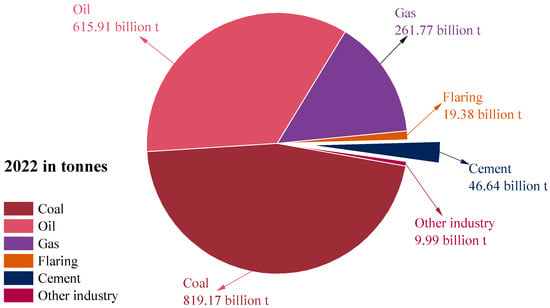
Figure 1
Open AccessArticle
Development of Sustainable Composite Sandwich with Wood Waste and Natural Fibers for Circular Economy Applications
by
Sofia Gomes, Paulo Santos and Tânia M. Lima
Recycling 2025, 10(4), 131; https://doi.org/10.3390/recycling10040131 - 2 Jul 2025
Abstract
►▼
Show Figures
Sustainability and the circular economy are increasingly recognized as global priorities, particularly in industrial waste management. This study explores the development of a sustainable composite material using wood waste and natural fibers, contributing to circular economy practices. Sandwich panels were manufactured with a
[...] Read more.
Sustainability and the circular economy are increasingly recognized as global priorities, particularly in industrial waste management. This study explores the development of a sustainable composite material using wood waste and natural fibers, contributing to circular economy practices. Sandwich panels were manufactured with a green epoxy resin matrix, incorporating wood waste in the core and flax fibers in the outer layers. Mechanical tests on the sandwich panel revealed a facing bending stress of 92.79 MPa and a core shear stress of 2.43 MPa. The panel demonstrated good compressive performance, with an edgewise compressive strength of 61.39 MPa and a flatwise compressive strength of 96.66 MPa. The material’s viscoelastic behavior was also characterized. In stress relaxation tests (from an initial 21 MPa), the panel’s stress decreased by 20.2% after three hours. The experimental relaxation data were successfully fitted by the Kohlrausch–Williams–Watts (KWW) model for both short- and long-term predictions. In creep tests, the panel showed a 21.30% increase in displacement after three hours under a 21 MPa load. For creep behavior, the KWW model was preferable for short-term predictions, while the Findley model provided a better fit for long-term predictions.
Full article
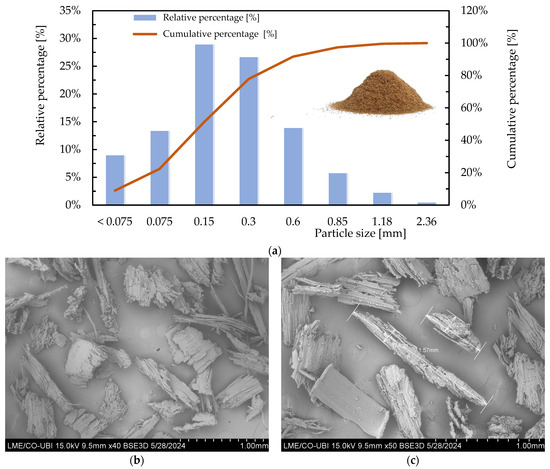
Figure 1
Open AccessArticle
Efficiency Determination of Water Lily (Eichhornia crassipes) Fiber Delignification by Electrohydrolysis Using Different Electrolytes
by
R. Sanchez-Torres, E. Onofre Bustamante, T. Pérez López and A. C. Espindola-Flores
Recycling 2025, 10(4), 130; https://doi.org/10.3390/recycling10040130 - 1 Jul 2025
Abstract
Nowadays, biomass use has increased due to it being the most abundant raw material on the planet, and treating it is a difficult task, as a result of the number of existing methods and the applications’ diversification. This research work shows the results
[...] Read more.
Nowadays, biomass use has increased due to it being the most abundant raw material on the planet, and treating it is a difficult task, as a result of the number of existing methods and the applications’ diversification. This research work shows the results obtained using different delignification methods (physical and chemical) on water lily ((Eichhornia crassipes) fiber lignocellulosic biomass including a seldom exploited method, known as “electrohydrolysis” in order to determinate the removal efficiency of lignin and hemicellulose. The characterization of the physicochemical and morphological properties of the water lily (Eichhornia crassipes) fiber before and after the pretreatments were applied were by means of Fourier Transform Infrared (FT-IR), X-ray diffraction (XRD) and optical microscopy (OM). The results of FT-IR show a significant decrease in the bands associated with lignin and hemicellulose. By XRD, it was determined that the crystallinity of the cellulose increased by 60% for the treated samples with respect to the reference, and an increase in the surface roughness of the samples was observed by OM. In conclusion, it was determined that electrochemistry delignification is an efficient, environmentally friendly methodology to remove the soluble sugars, opening the possibility to use the water lily (Eichhornia crassipes) fiber to produce a green concrete.
Full article
(This article belongs to the Special Issue Biomass Revival: Rethinking Waste Recycling for a Greener Future)
►▼
Show Figures
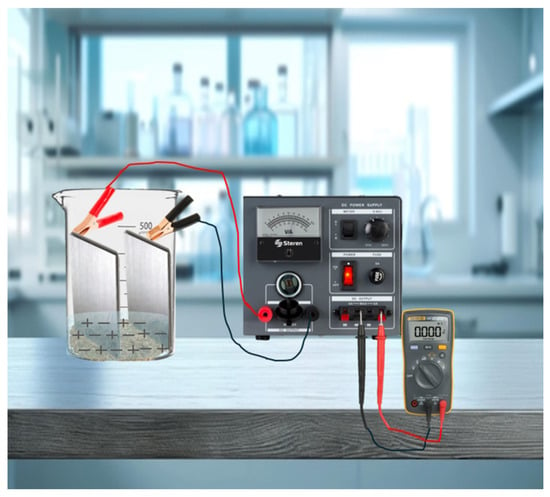
Figure 1
Open AccessArticle
Sustainable Mobile Phone Waste Management: Behavioral Insights and Educational Interventions Through a University-Wide Survey
by
Silvia Serranti, Riccardo Gasbarrone, Roberta Palmieri and Giuseppe Bonifazi
Recycling 2025, 10(4), 129; https://doi.org/10.3390/recycling10040129 - 1 Jul 2025
Abstract
Mobile phone waste management is a growing environmental challenge, with improper disposal contributing to resource depletion, pollution and missed opportunities for material recovery. This study presents the findings of a dual-purpose survey (11,163 respondents) conducted in a wide academic context in Italy, aimed
[...] Read more.
Mobile phone waste management is a growing environmental challenge, with improper disposal contributing to resource depletion, pollution and missed opportunities for material recovery. This study presents the findings of a dual-purpose survey (11,163 respondents) conducted in a wide academic context in Italy, aimed at both assessing mobile phones disposal behaviors and knowledge and raising awareness through structured educational prompts about sustainable e-waste management. The results reveal significant behavioral patterns and knowledge gaps across demographic groups. While most respondents (90.6%) own one phone, males tend to have more than females. Phones are replaced every 3–5 years by 48.8% of users and every 1–3 years by 36.7%, with students tending to replace them earlier. Only 20.2% replace their phone when irreparable while 46% replace them due to high repair costs. A large majority (92.3%) store old devices at home, forming an estimated urban mine of 29,799 unused phones. The awareness of hazardous components is higher than that of critical raw materials, with males more informed than females and students in scientific fields displaying greater awareness than those in humanities and health disciplines. The awareness of official take-back programs is particularly low, especially among younger generations. Notably, 90% reported increased awareness from the educational survey and 93.1% expressed willingness to use an on-campus e-waste collection system. These results highlight the role of universities as catalysts for sustainable behavior, supporting the design of targeted educational strategies and policy actions in line with circular economy principles and Sustainable Development Goal 12 “Responsible consumption and production”.
Full article
(This article belongs to the Special Issue Sustainability Education for Recycling: Multidisciplinary Approaches and Innovative Practices)
►▼
Show Figures
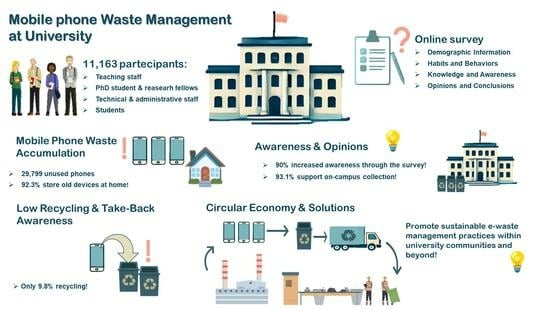
Graphical abstract
Open AccessArticle
From Waste to Product: New Circularity by Recovering Polypropylene from Mixed Commercial Waste
by
Maximilian Julius Enengel, Julia Roitner, Lisa Kandlbauer, Tatjana Lasch, Markus Lehner and Renato Sarc
Recycling 2025, 10(4), 128; https://doi.org/10.3390/recycling10040128 - 27 Jun 2025
Abstract
►▼
Show Figures
To meet the EU’s ambitious recycling targets, it is crucial to expand mechanical recycling to include currently underutilized waste streams, such as mixed commercial waste (MCW), which today achieves a recycling rate of only 3–5%. This study addresses the challenge of recovering polypropylene
[...] Read more.
To meet the EU’s ambitious recycling targets, it is crucial to expand mechanical recycling to include currently underutilized waste streams, such as mixed commercial waste (MCW), which today achieves a recycling rate of only 3–5%. This study addresses the challenge of recovering polypropylene (PP) from MCW and demonstrates a viable process to do so. The goal was to develop and test industrial-scale process concepts to extract PP and transform it into high-quality recyclate. Two process concepts were developed and tested at industrial scale to extract PP as a pre-concentrate. The recovered material was further sorted, shredded, washed, and granulated, ultimately reaching End-of-Waste status. Material analysis confirmed that the resulting PP granulate meets all relevant quality standards. A total of 456.8 kg of this recyclate was processed into market-ready products. To the best of the authors’ knowledge, this is the first demonstration of plastic products made entirely from MCW. By covering the full value chain—from waste to final product—this study highlights a viable and scalable approach for integrating complex waste streams into high-quality material cycles, thereby contributing to circular economy strategies.
Full article
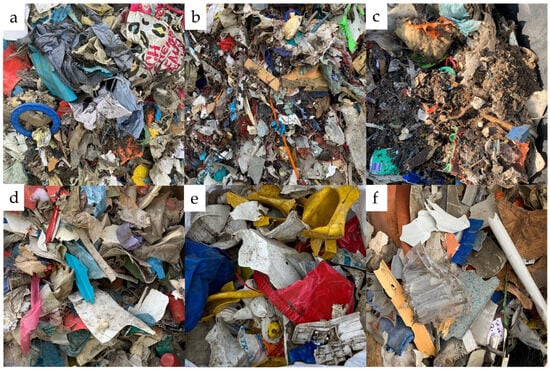
Figure 1
Open AccessArticle
Rebound Effect Generated by Waste HDPE in Hot Asphalt Mixtures
by
David Sepúlveda-Valdez, Julio Calderón-Ramírez, Ricardo Cota-Ramírez, José Manuel Gutiérrez-Moreno, Marco Montoya-Alcaraz, Leonel García-Gómez and Atondo Sánchez-Atondo
Recycling 2025, 10(4), 127; https://doi.org/10.3390/recycling10040127 - 26 Jun 2025
Abstract
The feasibility of using high-density polyethylene (HDPE) waste in hot asphalt mixtures was analyzed, with particular focus on the rebound effect generated during compaction. Traditional asphalt mixtures without additives were evaluated alongside mixtures modified with varying percentages of HDPE waste (0.5%, 0.62%, 1%,
[...] Read more.
The feasibility of using high-density polyethylene (HDPE) waste in hot asphalt mixtures was analyzed, with particular focus on the rebound effect generated during compaction. Traditional asphalt mixtures without additives were evaluated alongside mixtures modified with varying percentages of HDPE waste (0.5%, 0.62%, 1%, 4%, and 5%) through the dry method. In this method, crushed HDPE was incorporated as an aggregate within the asphalt mixture structure, added prior to the introduction of the asphalt binder. Laboratory tests assessed compaction, specific gravity (Gmb and Gmm), void content, and resistance to permanent deformation via the Hamburg wheel tracking test. The results indicated that high percentages of HDPE (4% and 5%) triggered a rebound effect that hindered proper compaction of the mixtures, thereby compromising structural integrity. Conversely, mixtures with lower HDPE percentages (0.5% and 0.62%) exhibited better compaction, although they remained comparable to the traditional mixtures without plastic. In conclusion, HDPE does not constitute a viable option for enhancing the properties of asphalt mixtures at high percentages due to elastic behavior during compaction, which introduces densification irregularities. However, some benefits were observed in mixtures with low HDPE percentages, including improvements in stability and resistance to deformation. Nonetheless, these advantages are insufficient to justify replacing traditional asphalt mixtures.
Full article
(This article belongs to the Special Issue Recycled Materials in Sustainable Pavement Innovation)
►▼
Show Figures
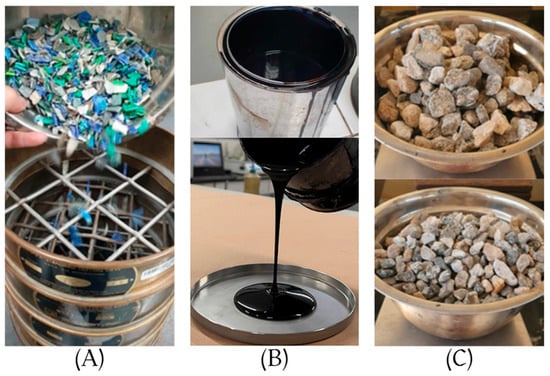
Figure 1
Open AccessArticle
Evaluation of Bio-Polyurethane Foam Synthesized from Liquefied Waste Wood Polyol
by
Go Masuda, Christian Ebere Enyoh, Keiju Ishidoya, Weiqian Wang and Qingyue Wang
Recycling 2025, 10(4), 126; https://doi.org/10.3390/recycling10040126 - 22 Jun 2025
Abstract
►▼
Show Figures
Bio-polyurethane foam was synthesized in this study using bio-polyol derived from liquefied waste wood as a sustainable alternative to petroleum-based polyols. It has been widely reported that polyurethane foams incorporating liquefied wood exhibit biodegradability when buried in soil, with assessments typically relying on
[...] Read more.
Bio-polyurethane foam was synthesized in this study using bio-polyol derived from liquefied waste wood as a sustainable alternative to petroleum-based polyols. It has been widely reported that polyurethane foams incorporating liquefied wood exhibit biodegradability when buried in soil, with assessments typically relying on CO2 emission measurements in a close system. However, this method cannot obtain any chemical bonding breakage information of the bio-polyurethane foam. On the other hand, our study investigated the biodegradation process by employing an elemental composition analysis using a CHN coder and functional group analysis through Fourier transform infrared (FT-IR) spectroscopy to capture chemical structure changing. The results demonstrated that biodegradation occurs in three different stages over time, even in the absence of significant early-stage weight loss. The gradual breakdown of urethane bonds was confirmed through changes in the elemental composition and functional group ratios, providing a more detailed understanding of the degradation mechanism. These findings suggest highlighting the importance of complementary chemical analytical techniques for a more accurate evaluation. On the other hand, TG data showed that bio-polyurethane foams remained thermally stable even after biodegradation occurred.
Full article
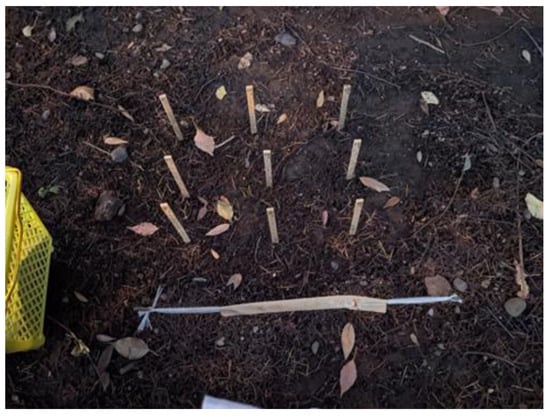
Figure 1
Open AccessArticle
Organic Waste and Wastewater Sludge to Volatile Fatty Acids and Biomethane: A Semi-Continuous Biorefinery Approach
by
Paolo S. Calabrò, Domenica Pangallo, Mariastella Ferreri, Altea Pedullà and Demetrio A. Zema
Recycling 2025, 10(4), 125; https://doi.org/10.3390/recycling10040125 - 21 Jun 2025
Abstract
Volatile fatty acids (VFA) are valuable intermediates with growing demand in chemical, pharmaceutical, and environmental applications. Their sustainable production from organic waste is increasingly explored in the context of circular economy and biorefinery models. This study investigates the co-fermentation of waste-activated sludge (WAS)
[...] Read more.
Volatile fatty acids (VFA) are valuable intermediates with growing demand in chemical, pharmaceutical, and environmental applications. Their sustainable production from organic waste is increasingly explored in the context of circular economy and biorefinery models. This study investigates the co-fermentation of waste-activated sludge (WAS) and the organic fraction of municipal solid waste (OFMSW) as a strategy for integrated VFA and biogas production. Semi-continuous experiments were carried out to assess the effect of the substrates ratio (WAS:OFMSW = 90:10 and 30:70), hydraulic retention time (HRT), and pH control (5, 9, no control) on VFA yield and composition. Results showed that higher OFMSW content and alkaline conditions favoured VFA production, with a maximum yield of 144.9 mgHAc·gVS−1 at pH 9 and 70:30 ratio. Acetate dominated, while butyrate production peaked at 114.1 mgHBu·gVS−1 under high sludge conditions. However, the addition of alkali required for pH control may lead to excessive accumulation of alkaline-earth metal ions, which can disrupt biological processes due to their potential toxicity. Anaerobic digestion of fermentation residues enhanced biomethane yields significantly (0.27 NL·gVS−1 vs. 0.05 NL·gVS−1 from raw sludge). The proposed process demonstrates potential for converting wastewater treatment plants into biorefineries, maximising resource recovery while reducing environmental impact.
Full article
(This article belongs to the Special Issue Biomass Revival: Rethinking Waste Recycling for a Greener Future)
►▼
Show Figures

Graphical abstract
Open AccessArticle
Characterization of Processes Aimed at Maximizing the Reuse of Brewery’s Spent Grain: Novel Biocomposite Materials, High-Added-Value Molecule Extraction, Codigestion and Composting
by
Jessica Di Mario, Agnese Bertoldi, Dario Priolo, Eleonora Calzoni, Alberto Maria Gambelli, Franco Dominici, Marco Rallini, Daniele Del Buono, Debora Puglia, Carla Emiliani and Giovanni Gigliotti
Recycling 2025, 10(4), 124; https://doi.org/10.3390/recycling10040124 - 21 Jun 2025
Abstract
►▼
Show Figures
Brewery’s spent grain (BSG) consists of the largest by-product by volume in the beer production sector and offers potential for both bio-composite material production, high-added-value molecular extraction and bioenergy recovery. Aiming at exploring the ideal biorefinery approach for this agro-industrial residual, the present
[...] Read more.
Brewery’s spent grain (BSG) consists of the largest by-product by volume in the beer production sector and offers potential for both bio-composite material production, high-added-value molecular extraction and bioenergy recovery. Aiming at exploring the ideal biorefinery approach for this agro-industrial residual, the present study experimentally investigated several methodologies to enhance the reuse of BSG and proposed a scheme of biorefinery focused on it. According to it, BSGs were firstly tested to produce high-added-value byproducts, such as protein hydrolysates and for the extraction of lignin via ionic liquids-based methods. The residuals were then used for biogas/biomethane production via anaerobic codigestion. The different matrices were rearranged in varying mixtures, aiming at ensuring high availability of nutrients for methanogens, thus achieving higher energy production than what achievable with untreated BSG. For the scope, further agro-industrial wastes were considered. The resulted digestate was finally composted. Untreated BSGs were also directly tested as fillers for bio-composite material production (in a mixture with PHB). Different concentrations were tested and the mechanical properties of each sample were compared with those of pure PHB. Disintegration tests were finally carried out to measure the improved biodegradability of the produced bio-composite material.
Full article
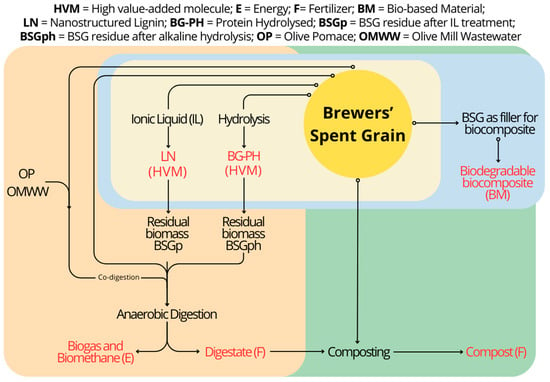
Figure 1
Open AccessReview
Waste Valorization Technologies in Tannery Sludge, Chromite, and Magnesite Mining
by
Evgenios Kokkinos, Effrosyni Peleka, Evangelos Tzamos and Anastasios Zouboulis
Recycling 2025, 10(4), 123; https://doi.org/10.3390/recycling10040123 - 20 Jun 2025
Abstract
►▼
Show Figures
Waste valorization involves reusing and recycling waste materials to create useful products such as materials, chemicals, fuels, or energy. The primary goal is the transition to a circular economy model while minimizing the impacts of hazardous waste. Adopting such policies appears to be
[...] Read more.
Waste valorization involves reusing and recycling waste materials to create useful products such as materials, chemicals, fuels, or energy. The primary goal is the transition to a circular economy model while minimizing the impacts of hazardous waste. Adopting such policies appears to be a one-way path due to the continuous increase in the consumption of raw materials. According to recent projections, by 2050, 180 billion tonnes of materials will be consumed annually. Since natural resources cannot meet these requirements, new sources must be explored. Waste can serve as an alternative source and cover at least part of the needs that arise. In this work, good practices regarding waste valorization are presented. The case studies examined include the waste/by-products of ultrabasic rocks resulting in chromite and magnesite mining, as well as the tannery sludge produced after the corresponding wastewater treatment.
Full article
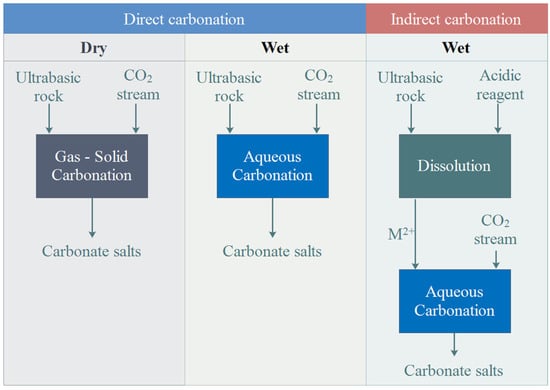
Figure 1
Open AccessArticle
Global Supply of Secondary Lithium from Lithium-Ion Battery Recycling
by
Carolin Kresse, Britta Bookhagen, Laura Buarque Andrade and Max Frenzel
Recycling 2025, 10(4), 122; https://doi.org/10.3390/recycling10040122 - 20 Jun 2025
Abstract
The recycling of lithium-ion batteries is picking up rather slowly, although recent rapid growth in consumption and increasing prevalence of battery electric vehicles have increased the quantity of recoverable material from past years of production. Yet, the diversity of different product types i.e.,
[...] Read more.
The recycling of lithium-ion batteries is picking up rather slowly, although recent rapid growth in consumption and increasing prevalence of battery electric vehicles have increased the quantity of recoverable material from past years of production. Yet, the diversity of different product types i.e., chemistries and product life spans complicates the recovery of raw materials. At present, large-scale industrial recycling of lithium-ion batteries employs (1) pyrometallurgy, with downstream hydrometallurgy for recovery of refined metals/salts; and (2) hydrometallurgy, requiring upstream mechanical shredding of cells and/or modules. Regulatory requirements, especially in Europe, and the high industry concentration along the lithium-ion battery value chain drive recycling efforts forward. The present study aims to quantify the potential contribution of 2nd lithium from recycling to battery production on a global and European scale up to 2050. The overall recycling output of lithium in any given year depends on the interactions between several different factors, including past production, battery lifetime distributions, and recovery rates, all of which are uncertain. The simplest way to propagate input uncertainties to the final results is to use Monte Carlo-type simulations. Calculations were done separately for EVs and portable batteries. The overall supply of lithium from recycling is the sum of the contributions from EVs and portable electronics from both the EU and the RoW in each battery production scenario. Results show a total global supply of recycled lithium below 20% in each scenario until 2050. On the EU level, the contribution of recycled lithium may reach up to 50% due to the high collection and recovery rate targets.
Full article
(This article belongs to the Special Issue Lithium-Ion and Next-Generation Batteries Recycling)
►▼
Show Figures
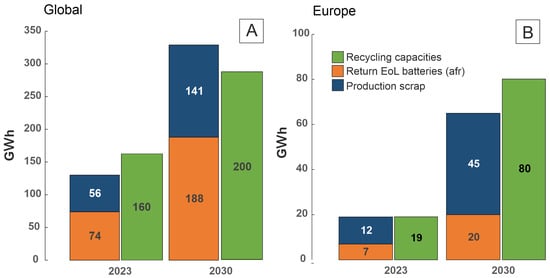
Figure 1
Open AccessArticle
Conceptual Recycling Chain for Proton Exchange Membrane Water Electrolyzers—Case Study Involving Review-Derived Model Stack
by
Malena Staudacher, Dominik Goes, Sohyun Ahn, Dzeneta Vrucak, Tim Gießmann, Bernhard Bauer-Siebenlist, Thomas Leißner, Martin Rudolph, Jürgen Fleischer, Bernd Friedrich and Urs A. Peuker
Recycling 2025, 10(3), 121; https://doi.org/10.3390/recycling10030121 - 19 Jun 2025
Abstract
►▼
Show Figures
The recycling of proton exchange membrane water electrolyzer (PEMWE) raw materials is imperative due to their scarcity, cost, complexity and environmental impact. This is particularly true in the context of expanding electrolyzer manufacturing and reducing production costs. Developing comprehensive recycling strategies requires the
[...] Read more.
The recycling of proton exchange membrane water electrolyzer (PEMWE) raw materials is imperative due to their scarcity, cost, complexity and environmental impact. This is particularly true in the context of expanding electrolyzer manufacturing and reducing production costs. Developing comprehensive recycling strategies requires the creation of a model stack due to the diversity in stack design, structure and materials. The review-derived model presented here provides a sound basis and summarizes the variety of approaches found in the literature and industry. The holistically developed recycling chain, including dismantling, mechanical processing, hydrometallurgical processes and carbon reuse, is characterized by the complete recycling of materials, the reduced application of energy-intensive process steps and the avoidance of environmentally harmful processes. Emphasis is placed on demonstrating the non-destructive disassembly of joined components, the dry mechanical decoating of catalyst-coated membranes, membrane dissolution, the separation of anode and cathode particles and the environmentally friendly hydrometallurgical processing of platinum.
Full article

Figure 1
Open AccessArticle
Valorization of Underused Biomass of Acacia dealbata and Acacia melanoxylon Through Vermicomposting as an Alternative Substrate for Cucumber Production
by
Maria C. Morais, Elisabete Nascimento-Gonçalves, Tiago Azevedo, Henda Lopes, Helena Ferreira, Ana M. Coimbra, Berta Gonçalves, João R. Sousa, Marta Roboredo and Paula A. Oliveira
Recycling 2025, 10(3), 120; https://doi.org/10.3390/recycling10030120 - 17 Jun 2025
Abstract
Invasive alien species are one of the main threats to global biodiversity, and pose significant management challenges in several areas outside their natural range. In southern Mediterranean Europe, the invasion of Acacia species is particularly severe and its control requires costly and often
[...] Read more.
Invasive alien species are one of the main threats to global biodiversity, and pose significant management challenges in several areas outside their natural range. In southern Mediterranean Europe, the invasion of Acacia species is particularly severe and its control requires costly and often ineffective actions. The use of vermicompost derived from these species to replace peat-based substrates in horticulture offers a promising alternative to mitigate their economic and environmental impacts while enhancing the sustainability of their control. This study explored the potential of vermicompost produced from the fresh aboveground waste biomass (leaves + stems + flowers) of Acacia dealbata and Acacia melanoxylon (75:25 w/w), two of the most aggressive Acacia species in the Mediterranean, using Eisenia fetida over twelve weeks. In essence, this study aimed to evaluate the quality of the produced vermicompost and its suitability as a partial substitute for potting substrate in the production of cucumber (Cucumis sativus) seedlings for transplant. Four substrate mixtures containing 0%, 10%, 30%, and 50% of Acacia vermicompost (w/w), combined with commercial peat-based potting substrate and perlite (20%) were tested in polystyrene seedling trays. Seedling emergence, growth, and leaf biochemical parameters (photosynthetic pigments, phenolics, soluble sugars and starch, and total thiobarbituric acid-reactive substances—TBARSs) were evaluated. The results showed that the addition of Acacia vermicompost to the commercial substrate did not affect its germination but significantly enhanced seedling growth, particularly in mixtures containing 30% and 50% Acacia vermicompost. In addition, the absence of accumulation of TBARSs also reflected the superiority of these two treatments. These findings suggest that vermicompost derived from A. dealbata and A. melanoxylon biomass can be a viable peat-based substrate alternative for horticultural production, with the dual benefit of promoting sustainable agricultural practices and contributing to invasive species management.
Full article
(This article belongs to the Special Issue Biomass Revival: Rethinking Waste Recycling for a Greener Future)
►▼
Show Figures

Figure 1
Open AccessArticle
Graphene Recovery in Both Dispersed and Decanted Fractions from Lithium-Ion Battery Graphite via Sonication
by
Erasmo Arriola-Villaseñor, Alba Nelly Ardila Arias, Santiago Bedoya Betancour, Luz Marina Ocampo-Carmona, Trino Armano Zepeda Partida, Sergio A. Gómez Torres and Gustavo Ariel Fuentes Zurita
Recycling 2025, 10(3), 119; https://doi.org/10.3390/recycling10030119 - 17 Jun 2025
Abstract
In this study, graphene production via liquid-phase exfoliation assisted by sonication was evaluated using deionized water as a solvent and two graphite sources: one recovered from spent lithium-ion batteries (LIBs) and a commercial counterpart. A 750 W, 20 kHz ultrasonic processor was used,
[...] Read more.
In this study, graphene production via liquid-phase exfoliation assisted by sonication was evaluated using deionized water as a solvent and two graphite sources: one recovered from spent lithium-ion batteries (LIBs) and a commercial counterpart. A 750 W, 20 kHz ultrasonic processor was used, with sonication amplitudes ranging from 50% to 80% for two hours while maintaining a constant temperature of 45 °C. The resulting dispersions were left undisturbed for 24 h at ambient temperature to allow natural phase separation between decanted and dispersed fractions. These fractions were subsequently dried and weighed to determine exfoliation yield. High-quality graphene was successfully obtained via direct liquid-phase exfoliation of graphite recovered from LIBs, assisted by sonication in deionized water. Graphene formation was confirmed in both suspended and decanted fractions after two hours of sonication at 80% amplitude through complementary characterization techniques, including UV-Vis, Raman spectroscopy, HRTEM, and XRD. Comparative experiments using thermally pretreated battery graphite and commercial graphite revealed that graphene dispersions derived from untreated LIB-derived graphite exhibited greater long-term stability than those obtained from commercial or thermally pretreated battery graphite before sonication.
Full article
(This article belongs to the Special Issue Lithium-Ion and Next-Generation Batteries Recycling)
►▼
Show Figures

Figure 1
Highly Accessed Articles
Latest Books
E-Mail Alert
News
Topics
Topic in
Buildings, Clean Technol., Materials, Recycling, Sustainability
Circular Economy Innovations and Breakthroughs for Built Environments
Topic Editors: Sakdirat Kaewunruen, Katerina Tsikaloudaki, Ruben P. Borg, Yunlong GuoDeadline: 31 August 2025
Topic in
Materials, Mining, Recycling, Resources, Sustainability, Minerals, Geosciences, Environments
Sustainable Recycling and Reuse of Industrial By-Products or Waste from Geo-Resource Exploitation
Topic Editors: Sossio Fabio Graziano, Rossana Bellopede, Giovanna Antonella Dino, Nicola CaredduDeadline: 30 November 2025
Topic in
Clean Technol., Materials, Molecules, Recycling, Water, Nanomaterials, Catalysts
Advanced Composites for Waste Valorization and Pollutant Degradation
Topic Editors: Iwona Kuzniarska-Biernacka, Ana Sofia MestreDeadline: 31 January 2026
Topic in
J. Compos. Sci., Materials, Molecules, Nanomaterials, Polymers, Processes, Recycling
Science and Technology of Polymeric Blends, Composites, and Nanocomposites
Topic Editors: Roberto Scaffaro, Emmanuel Fortunato GulinoDeadline: 28 February 2026

Conferences
Special Issues
Special Issue in
Recycling
Recycled Materials in Sustainable Pavement Innovation
Guest Editors: José Neves, Ana Cristina FreireDeadline: 15 July 2025
Special Issue in
Recycling
Lithium-Ion and Next-Generation Batteries Recycling
Guest Editor: Sascha NowakDeadline: 31 August 2025
Special Issue in
Recycling
Biomass Revival: Rethinking Waste Recycling for a Greener Future
Guest Editor: Salustiano Mato De La IglesiaDeadline: 1 October 2025
Special Issue in
Recycling
Rubber Waste and Tyre Stewardship
Guest Editor: Shifeng WangDeadline: 31 October 2025







